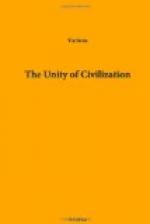Such were the bases on which the unity of mediaeval civilization had to depend. There was a contracted world, which men could regard as a unity, with a single centre of coherence. There was a low stage of economic development, which on the one hand meant a general uniformity of life, in fief and manor and town, and on the other hand meant a local isolation, that needed, and in the unity of the Church found, some method of unification. With many varieties of dialect, there was yet a general identity of language, which made possible the development, and fostered the dissemination, of a single and identical culture. Nationalism, whether as an economic development, or as a way of life and a mode of the human spirit, was as yet practically unknown. Races might disagree; classes might quarrel; kings might fight; there was hardly ever a national conflict in the proper sense of the word. The mediaeval lines of division, it is often said, were horizontal rather than vertical. There were different estates rather than different states. The feudal class was homogeneous throughout Western Europe: the clerical class was a single corporation through all the extent of Latin Christianity; and the peasantry and the townsfolk of England were very little different from the peasantry and the townsfolk of France. We have to think of a general European system of estates rather than of any balance of rival powers.
II
The unity which rested on these bases begins to appear, as a reality and not only an idea, about the middle of the eleventh century, and lasts till the end of the thirteenth. That unity, as we have seen, was essentially ecclesiastical. It was the product of the Church: we may almost say that it was the Church. Before 1050 the Catholic Church, however universal in theory, had hardly been universal in fact. The period of the Frankish, the Saxon, and the early Salian emperors had been a period of what German writers call the Landeskirche. The power of the Bishop of Rome had not yet been fully established; and the great churches of Reims and Mainz and Milan were practically independent centres. Independent of the papacy, they were not independent of the lay rulers within whose dominions they lay. On the contrary, their members were deeply engaged in lay activities; they were landlords, feudatories, and officials in their various countries. In the face of these facts, the Gregorian movement of the eleventh century pursues two closely interconnected objects. It aims at asserting the universal primacy of the papacy; it aims at vindicating the freedom of the clergy from all secular power. The one aim is a means to the other: the pope cannot be universal primate, unless the clergy he controls are free from secular control; and the clergy cannot be free from secular control, unless the universal primacy of the papacy effects their liberation. Gregorianism wins a great if not a thorough triumph. It establishes




